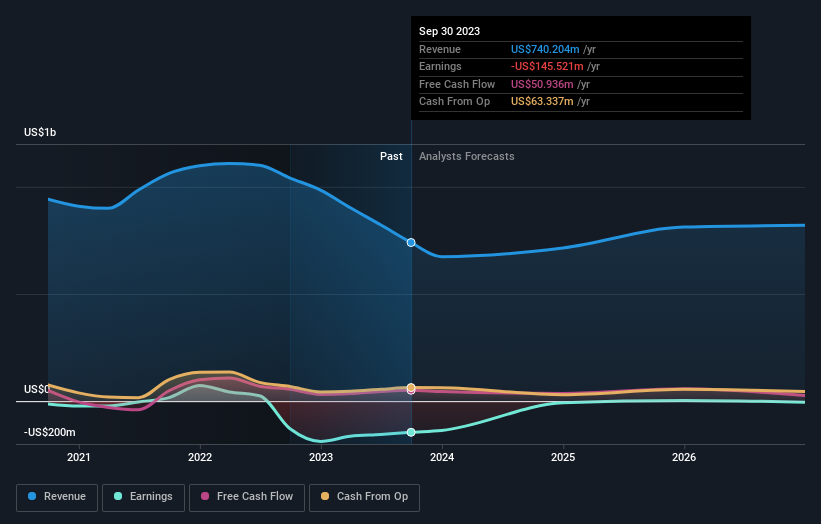Stock Analysis
- United States
- /
- Consumer Finance
- /
- NasdaqGS:TREE
Following a 18% decline over last year, recent gains may please LendingTree, Inc. (NASDAQ:TREE) institutional owners

Key Insights
- Given the large stake in the stock by institutions, LendingTree's stock price might be vulnerable to their trading decisions
- A total of 10 investors have a majority stake in the company with 50% ownership
- 18% of LendingTree is held by insiders
If you want to know who really controls LendingTree, Inc. (NASDAQ:TREE), then you'll have to look at the makeup of its share registry. And the group that holds the biggest piece of the pie are institutions with 61% ownership. In other words, the group stands to gain the most (or lose the most) from their investment into the company.
Institutional investors would appreciate the 14% increase in share price last week, given their one-year losses have totalled a disappointing 18%.
Let's delve deeper into each type of owner of LendingTree, beginning with the chart below.
See our latest analysis for LendingTree

What Does The Institutional Ownership Tell Us About LendingTree?
Institutions typically measure themselves against a benchmark when reporting to their own investors, so they often become more enthusiastic about a stock once it's included in a major index. We would expect most companies to have some institutions on the register, especially if they are growing.
We can see that LendingTree does have institutional investors; and they hold a good portion of the company's stock. This suggests some credibility amongst professional investors. But we can't rely on that fact alone since institutions make bad investments sometimes, just like everyone does. When multiple institutions own a stock, there's always a risk that they are in a 'crowded trade'. When such a trade goes wrong, multiple parties may compete to sell stock fast. This risk is higher in a company without a history of growth. You can see LendingTree's historic earnings and revenue below, but keep in mind there's always more to the story.

Since institutional investors own more than half the issued stock, the board will likely have to pay attention to their preferences. We note that hedge funds don't have a meaningful investment in LendingTree. The company's CEO Douglas Lebda is the largest shareholder with 17% of shares outstanding. BlackRock, Inc. is the second largest shareholder owning 12% of common stock, and The Vanguard Group, Inc. holds about 5.8% of the company stock.
We did some more digging and found that 10 of the top shareholders account for roughly 50% of the register, implying that along with larger shareholders, there are a few smaller shareholders, thereby balancing out each others interests somewhat.
Researching institutional ownership is a good way to gauge and filter a stock's expected performance. The same can be achieved by studying analyst sentiments. There are a reasonable number of analysts covering the stock, so it might be useful to find out their aggregate view on the future.
Insider Ownership Of LendingTree
While the precise definition of an insider can be subjective, almost everyone considers board members to be insiders. The company management answer to the board and the latter should represent the interests of shareholders. Notably, sometimes top-level managers are on the board themselves.
Most consider insider ownership a positive because it can indicate the board is well aligned with other shareholders. However, on some occasions too much power is concentrated within this group.
Our most recent data indicates that insiders own a reasonable proportion of LendingTree, Inc.. Insiders own US$84m worth of shares in the US$468m company. It is great to see insiders so invested in the business. It might be worth checking if those insiders have been buying recently.
General Public Ownership
The general public-- including retail investors -- own 21% stake in the company, and hence can't easily be ignored. While this group can't necessarily call the shots, it can certainly have a real influence on how the company is run.
Next Steps:
It's always worth thinking about the different groups who own shares in a company. But to understand LendingTree better, we need to consider many other factors. Be aware that LendingTree is showing 2 warning signs in our investment analysis , and 1 of those doesn't sit too well with us...
But ultimately it is the future, not the past, that will determine how well the owners of this business will do. Therefore we think it advisable to take a look at this free report showing whether analysts are predicting a brighter future.
NB: Figures in this article are calculated using data from the last twelve months, which refer to the 12-month period ending on the last date of the month the financial statement is dated. This may not be consistent with full year annual report figures.
Valuation is complex, but we're helping make it simple.
Find out whether LendingTree is potentially over or undervalued by checking out our comprehensive analysis, which includes fair value estimates, risks and warnings, dividends, insider transactions and financial health.
View the Free AnalysisHave feedback on this article? Concerned about the content? Get in touch with us directly. Alternatively, email editorial-team (at) simplywallst.com.
This article by Simply Wall St is general in nature. We provide commentary based on historical data and analyst forecasts only using an unbiased methodology and our articles are not intended to be financial advice. It does not constitute a recommendation to buy or sell any stock, and does not take account of your objectives, or your financial situation. We aim to bring you long-term focused analysis driven by fundamental data. Note that our analysis may not factor in the latest price-sensitive company announcements or qualitative material. Simply Wall St has no position in any stocks mentioned.
About NasdaqGS:TREE
LendingTree
LendingTree, Inc., through its subsidiary, operates online consumer platform in the United States.
Reasonable growth potential and slightly overvalued.

